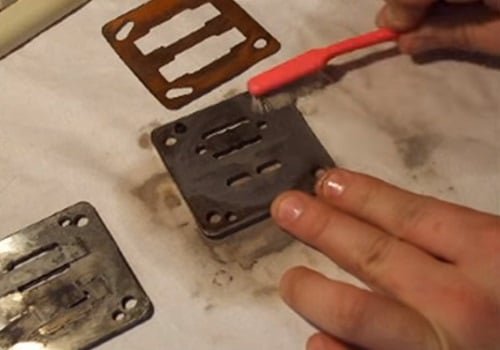Disclosure: This post contains affiliate links and I will be compensated if you make a purchase after clicking through my links. Learn More
Reed valves are an important part of an air compressor, and they need to be regularly cleaned in order to keep the compressor working properly. In this article, we will explain how to clean an air compressor reed valves, how to test reed valves and so on.
Without further ado, let’s jump right in!
How to Clean Reed Valves On an Air Compressor?
There are a few different ways to clean reed valves, and the best method will depend on the type of valve you have. If you have a plastic valve, you can use a soft brush to gently remove any dirt or debris that has collected on the surface. If you have a metal valve, you can use a wire brush to scrub away any build-up on the surface.
Instructions:

Step 1: Unplug the air compressor and remove any hoses or attachments
Step 2: Locate the reed valves on the side of the cylinder head
Step 3: Use a small screwdriver or other tool to gently pry the reed valves out of their seats
Step 4: Inspect the reed valves for wear or damage and replace if necessary
Step 5: Clean any debris from the seats and from the valves using a toothbrush
Step 6: Once the valves are clean reinstall them in their seats
Step 7: Reattach hoses or attachments and plug in the compressor to test
Allow the compressor to run for a few minutes to make sure that everything is working properly. If you still notice problems with your air compressor after cleaning the reed valves, be sure to contact a professional for assistance.
How Do Compressor Reed Valves Work?
Air compressor reed valves work by opening and closing in response to changes in pressure. When the pressure inside the compressor is higher than the atmospheric pressure, the reed valve will open, allowing air to flow into the compressor.
This increases the volume of air within the compressor, which raises the pressure. When the pressure inside the compressor falls below atmospheric pressure, the reed valve will close, preventing air from flowing out of the compressor. This maintains a constant pressure within the compressor, which is necessary for proper operation.
How Do You Test a Reed Valve on an Air Compressor?
If you think there may be an issue with your reed valve, there are a few tests you can perform to check its condition. One way to test the reed valve is by trying to start the compressor with the discharge valve closed. If air leaks from around the edges of the piston, then this is an indication that the reed valve is not sealing properly and needs to be replaced.
Another way to test the reed valve is by opening the discharge valve and watching for air bubbles in the oil. If there are bubbles present, this means that air is leaking past the reed valve and into the crankcase. This also indicates that the reed valve needs to be replaced.
What Are the Common Reed Valve Issues and How to Fix Them?
There are a few things that can go wrong with your reed valve, and here are some tips on how to troubleshoot them.
One problem that can occur is that the reed valve may become clogged with dirt or other debris. This can cause the valve to stick in the open position, which will prevent air from flowing into the compressor. To clean the valve, remove it from the compressor and soak it in a solution of vinegar and water for a few hours. Then, use a toothbrush to scrub away any remaining dirt or debris.
Another problem that can occur is that the spring inside the reed valve may break or become damaged. This will cause the valve to stay open all the time, which again will prevent air from flowing into the compressor. To fix this problem, you’ll need to replace the spring with a new one.
If your reed valve is still not working properly after following these tips, then you may need to replace it with a new one. Fortunately, replacement valves are relatively inexpensive and easy to find online or at your local hardware store.
What Are Air Compressor Reed Valves Made Of?
The materials that air compressor reed valves are made from can have a significant impact on their performance.
There are a few different options for reed valve material, each with its own advantages and disadvantages. The most common type of reed valve is made from steel.
Steel is strong and durable, making it ideal for high-pressure applications. However, it can be susceptible to corrosion over time. Aluminum is another popular option for reed valves.
It’s lightweight and has good resistance to corrosion, but it isn’t as strong as steel so it’s not ideal for high-pressure applications. Composite materials like carbon fiber or Kevlar are also used in some reed valves. These materials are very strong and lightweight, but they can be expensive.
Final Words
Hopefully, by reading this article you now understand how to clean reed valves on an air compressor and keep it running smoothly. Still, if you have any confusion over air compressors or reed valves just comment down below. We will respond with the best answer possible. Have a great day!
